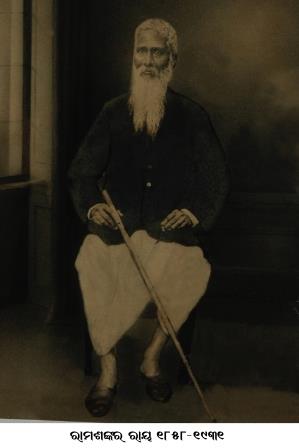Born :- 25-May-1857
Died :- 13-Sep-1931
Place of Birth :- Deekhitapada, Asureshwara, Cuttack

In the footprints of Karma-veer Gourishankar Ray, Ramshankar, his younger brother, Ray was an illustrious personality dedicated to social reform and promotion of nationalism through his works as an extra-ordinary playwright. His achievements were a landmark in Odiya theatre. Although not the first Oriya dramatist, he is credited as the first successful playwright. After watching a Bengali production in Cuttack In 1878, he resolved to write drama in Odia. He wrote his first play, Kanchi-Kaveri in 1880, which was staged in 1881. Protagonist of the play was Gajapati Purushottam Dev, illustrious king of of Odisha, through whose historic war with the king of Kanchi, Salva Narasimha Dev, Ray brought to life on stage the flourished Odia patriotism. The play won the hearts of audiences instantly by its popular nationalistic theme and attractive presentation.
Ramshankar Ray never looked back and by 1917 had written as many as fourteen historical, mythological, and social plays, including traditional Yatra, Lila, and downright farce. He was the first author to present Shakespeare in Odia. He adapted The Tempest in Odia and staged it in 1882, trying his best to adopt a Shakespearean style. However, keeping in view the taste of spectators, he had to follow Indian classical and folk traditions too.
Towards the end of the nineteenth century, under the influence of Western education, socially conscious Indian writers started dreaming of reform. Ray was no exception. In his social plays, he took the role of a reformist. Kalikal in 1883 dealt with the harmful effects of alcoholism. Budha-bara or "Old Groom" in 1892 dealt with problems created by older men marrying young girls. Bisha Modak or 'Poisonous Tablet' in 1900 dealt with intoxication and loans while Yuga-dharma i.e. "Dharma of the Age" in 1902 dealt with the rigidity of Hinduism. Elsewhere, he wrote about women's education, development through industrialisation, eradication of unemployment, and evils of the dowry system. He presented these issues in simple and lucid language, aided by ample but effective music. Even in his mythological plays, like Rama banabas or "Rama's Exile" in 1891, Kamsa-Vadh or "Kamsa's Killing" in 1896, "Chaitanya's Lila" in 1906, and Ramabhishek i.e. "Rama's Coronation" in 1917 his scientific outlook aimed to change the thought pattern of Odias.
Ramshankar Ray was also a novelist—he is credited as the first Odia novelist—but two of his novels, Soudamini and Unmadini, ended incomplete half way as the magazines in which they were being serialised closed down under various circumstances. His only compete novel was Bibasani. He also wrote a poetry book, ‘Prem Tari’, and translated a few of the prominent Vedas, Upanishads and the Srimad Bhagabat Geeta into Odia.
Ramshankar Ray was born in Dikshitpada village near Asureswar in Cuttack district on 20 May, 1857 and died on 13 September, 1931.
